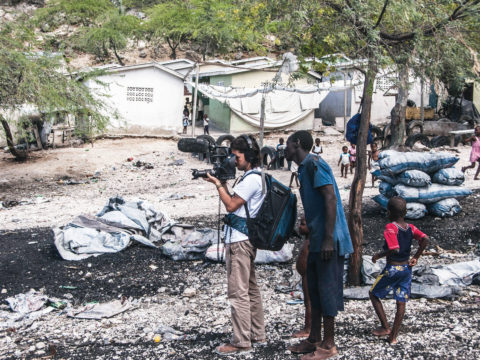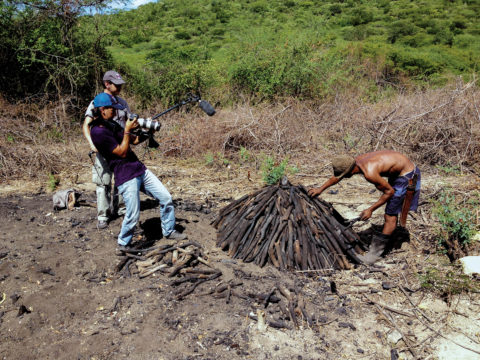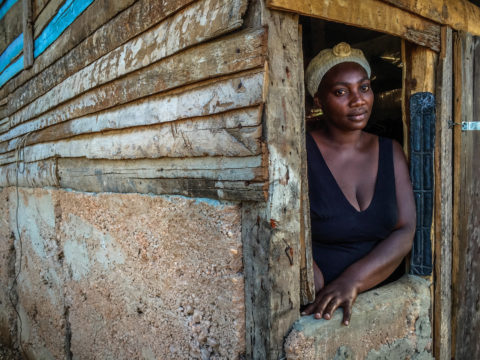► A Saudi woman filmmaker travels through her native country, overcoming many obstacles to tell the story of a thrill-seeking joyrider in Riyadh. She takes footage of the city on the fly, using her iPhone. Unable to meet with her male subject in person because of gender segregation rules, she hires a cameraman to shoot him instead.
► The teenage sons and daughters of undocumented immigrants visit Mexico for the first time since being secreted across the border as young children.
► A filmmaker travels to Rio de Janeiro and discovers that the city has not kept its promise to clean up the staggering pollution in Guanabara Bay in advance of the 2016 summer Olympic Games.
These bold, human stories often go untold, but UC Santa Cruz’s unique Film and Digital Media Department’s Social Documentation Program, affectionately known as “SocDoc,” is stepping into the breach, producing socially conscious films that bear witness, address injustice, and shine a bright light on neglected subjects.

Juan Mejia filming the charcoal market in Ravin Djab, Haiti, very close to the Dominican border city of Jimani.
Rich, fully formed characters help the filmmakers tell stories that cross borders, challenge preconceptions, and combine the personal with the political.
In the process, this innovative two-year program has created a bumper crop of edgy, talented, well-trained documentary filmmakers who are already winning prizes and hitting the festival circuit. This year marks the 10th anniversary of its first graduating class.
Students come from a wide variety of disciplines. Often, they bring with them the richness of their own cultures. SocDoc has attracted students from as far away as Argentina and Colombia. One recent student was a Fulbright scholar from Iceland.
These student moviemakers have a great responsibility, noted new UC Santa Cruz Arts Dean Susan Solt.
“You can’t look at SocDoc without appreciating what the filmmaker has to engage with: immersing yourself in the topic, gaining the knowledge, and then making it live as a work of art—grounded, of course, in truth, reality, and a mission,” she said.
SocDoc’s student filmmakers embody the ideal of the “citizen artist, creative people who loom large in the world, contributing and making a difference, shedding a light on problems and providing insight,” Solt said.
The program now offers a master’s degree, but it is transitioning into an M.F.A. program. Faculty hope the change will be complete within this academic year.
The evolution from M.A. to M.F.A. is significant for a few reasons. First, M.F.A. programs have a unique focus on the arts; SocDoc was founded in the Social Sciences, but moved over to the Arts Division and Film and Digital Media in 2011. Second, the M.F.A. allows SocDoc graduates to teach at the college and university level if they wish.
“Most universities will not even consider an applicant who does not hold an M.F.A.,” noted Film and Digital Media Chair Irene Gustafson.
Bearing witness
SocDoc is custom-made for documentarians who wish to immerse themselves in their topics and make artful, thoughtful films that can lead to social change. The visuals can be beautiful, and the techniques eye-catching—some make use of animation and graphics as well as state-of-the-art lighting and camera techniques—but these elements must serve the stories.

Juan Mejia (with camera) and Juan Yepes filming the building of a small charcoal oven on the Dominican border near the town of Galván
“We don’t fetishize style, but we do push people to be innovative,” said Assistant Professor Jennifer Maytorena Taylor, whose newest film, Message to Zaire, was broadcast on PBS in February. She wants her students to “tell stories authentically while pushing the envelope artistically.”
The student filmmakers retain their independence and their points of view. They are making sophisticated films, not public service announcements. Still, the professors expect them to be fair and accurate.
“We seek to have people look at subjects with nuance, to allow contradictions to co-exist because they do every day in our lives,” Taylor said.
Telling deep truths in a ‘post-fact’ world
In these foggy days of fake news stories and social media postings that blur fact and fantasy, SocDoc students work hard to capture the glorious messiness of real lives and situations.
“You know, a lot of people think you can just capture what is going on in the world by pointing a camera at it,” said B. Ruby Rich, a highly regarded professor in the SocDoc Program and a respected critic and film scholar. “But you can easily be misled. You have to know why you are pointing the camera, you have to be prepared, and know why you’re there.”
That’s why SocDoc is all about “context, immersion, and deep knowledge,” she said. “Preparation is so important. We don’t want students to arrive raw, a blank sheet, when they start their films. We want them to be as knowledgeable as can be. Sure, they’re learning film production, but they’re also taking classes in social science and research methodologies. All of that goes on in the first year before they even set foot in the place where they will be filming.”
One student filmmaker, Alex (Jorge) Flores, researched immigration history and U.S. politics before pursuing his project about undocumented students in California who are known as “Dreamers,” after the Development, Relief, and Education for Alien Minors (DREAM) Act. He followed a group of Dreamers in their late teens and early 20s as they ventured back to Mexico to visit relatives.
Other filmmakers have intensive real-world preparation for their projects before they even enter the program. Before enrolling, 2011 graduate Bridgette Auger had been living in Damascus, Syria, for two years, working as a still photographer for the United Nations and covering the country’s responses to the Iraqi refugee crisis. “I spent my days traveling around the country speaking with Iraqis about their experiences,” Auger said.
Auger’s student film, ElShelleh (The Guys), is about Iraqi musicians who resettled in El Cajon, California. “They were happy to be safe, but were frustrated because they were educated and talented musicians wasting away working at gas stations and 99-cent stores,” Auger said. The story was bittersweet; the men continued to support each other and make music as they adjusted to their new lives. As she made the film, program professors “helped me learn to articulate the visual ideas in my head,” said Auger, who was the recipient of a prestigious fellowship at the Bay Area Video Coalition in 2016.
Tales from the field
Professors advise their students in every step, from the theoretical aspects of filmmaking to the art of editing. But the professors also give these budding filmmakers advice drawn from life.
“One of my favorite aphorisms is that production is a carefully managed series of narrowly avoided catastrophes,” said Taylor. “I say that, of course, with tongue in cheek, but it’s also true. If you get through a documentary production intact and alive and have something even relatively good, you have beaten the odds. So many things can go wrong. If you go in thinking something will go wrong, you can deal with the setbacks and the unexpected, and figure out ways to make them part of the story.”
For instance, while shooting her widely praised 2009 documentary New Muslim Cool, which is about a hip-hop duo consisting of Hispanic Muslim brothers, she had to contend with an FBI raid on some of the characters’ homes. That incident changed the arc of the story that Taylor thought she was telling, but in the end it deepened and enriched the film.
Life after SocDoc
All of this training and life experience has real-world applications. So many students move on to impressive documentary filmmaking careers that Rich finds herself “constantly updating” the SocDoc list of outstanding alumni and their achievements.
Rich spoke with obvious pride when she mentioned that the prestigious Margaret Mead Film Festival, held every fall in New York City, has featured the work of one or two SocDoc alums without fail ever since it started showcasing the films of emerging documentarians.

Calina, the Haitian widow of a murdered Dominican park ranger, gazes at the camera. She is one of the protagonists of the film Death by a Thousand Cuts. This picture was taken in front of her house in the town of Puerto Escondido, Dominican Republic.
One recent success story, 2007 graduate Juan Mejia, directed Uprooted, a student film about the forced displacement of black communities in Colombia.
“I entered the program more as an anthropologist, really,’’ said Mejia. “I had some basic media experience but not that much. At SocDoc I really honed my skills, but there was also an intensive theoretical process. We learned a lot about how to make responsible and complex documentaries. You can still be committed politically to a story and tell it in a complex way.”
Mejia’s postgraduation work includes a feature documentary he codirected called Death by a Thousand Cuts, which examines the murder of a forest ranger on the Dominican/Haitian border. More than just the tale of a killing, the movie is also a story of transnational animosities and a thriving timber industry in an area that is supposedly off-limits to logging. It premiered as part of the Hot Docs International Film Festival in Canada and recently won the grand prize for documentary at the Seattle International Film Festival. The film also won the Audience Award at DOC NYC in New York.
“I admire the fact that the program allowed us to come into our stories from our deep political commitments,” Mejia said.
Not all students go on to documentary filmmaking careers. “It is a mix,” Gustafson said.
“Our model is to train people to be good enough at production basics that they can work as producers and editors, or work in sound.”
A career as a documentary filmmaker is not an easy one. Technology and online distribution have lowered the bar of entry and the cost of equipment while creating a glut of content. But SocDoc trains its students to stand out from the masses of aspiring filmmakers.
Besides, said Rich, “there is a hunger for new voices. Our students bring real passion to their work.”
The Film and Digital Media Department presents an exhibition of thesis films from the master’s program in Social Documentation annually in June at the Del Mar Theatre in downtown Santa Cruz. For more information about SocDoc, visit film.ucsc.edu/socdoc.

